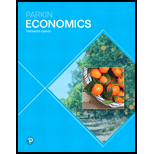
Macroeconomics
13th Edition
ISBN: 9780134735696
Author: PARKIN, Michael
Publisher: Pearson,
expand_more
expand_more
format_list_bulleted
Question
Chapter 24, Problem 22APA
To determine
Identify the impact of stock market crashes on the supply of loanable funds.
Expert Solution & Answer
Want to see the full answer?
Check out a sample textbook solution
Students have asked these similar questions
Based on Abel, Bernanke and Croushore, 10th edition, Chapter 4, Numerical Problems No. 1.
A consumer is making saving plans for this year and next. She knows her real income after
taxes will be $50,000 in both years. Any part of her income saved this year will earn a real
interest rate of 10% between this year and next year. Currently, the consumer has no wealth
(no money in the bank or other financial assets, and no debts). There is no uncertainty about
the future.
a) Formally derive the consumer’s intertemporal budget constraint.
b) Using the given numerical values rewrite and graph the budget line.
c) Find the consumer’s PVLR.
The consumer wants to save an amount this year that will allow her to (1) make college tuition
payments next year equal to $16,800 in real terms; (2) enjoy exactly the same amount of
consumption this year and next year, not counting tuition payments as part of next year’s
consumption; and (3) have neither assets nor debts at the end of next year.
d) In the…
Which of the following situations represent investment or saving? Explain.
Your family takes out a mortgage and buys a new house.
You use your $200 paycheck to buy stock in AT&T.
Your roommate earns $100 and deposits it in his account at a bank.
You borrow $1,000 from a bank to buy a car to use in your pizza delivery business.
For each of the following pairs, which bond would you expect to pay a higher interest rate? Explain.
A bond that repays the principal in year 2030 or a bond that repays the principal in year 2040. 2 . A bond from Coca-Cola or a bond from a software company you run in your garage.
The economy of Dream Island, which is isolated from the rest of the world, has the supply of loanable funds schedule and the demand for loanable funds schedule shown in the table below. As it happens, all of the supplies of loanable funds are from households' savings and the entre demand for loanable funds is from firms' investment demand. Real interest rate (percent per year) Supply of loanable funds (2005 dollars) Demand for loanable funds (2005 dollars) 5 2,000 5,000 7 3,000 4,000 9 4,000 3,000 11 5,000 2,000
a) Draw the demand and supply curves.
Chapter 24 Solutions
Macroeconomics
Ch. 24.1 - Prob. 1RQCh. 24.1 - Prob. 2RQCh. 24.1 - Prob. 3RQCh. 24.1 - Prob. 4RQCh. 24.2 - Prob. 1RQCh. 24.2 - Prob. 2RQCh. 24.2 - Prob. 3RQCh. 24.2 - Prob. 4RQCh. 24.2 - Prob. 5RQCh. 24.3 - Prob. 1RQ
Ch. 24.3 - Prob. 2RQCh. 24.3 - Prob. 3RQCh. 24.3 - Prob. 4RQCh. 24.3 - Prob. 5RQCh. 24.3 - Prob. 6RQCh. 24.4 - Prob. 1RQCh. 24.4 - Prob. 2RQCh. 24.4 - Prob. 3RQCh. 24 - Prob. 1SPACh. 24 - Prob. 2SPACh. 24 - Prob. 3SPACh. 24 - Prob. 4SPACh. 24 - Prob. 5SPACh. 24 - Prob. 6SPACh. 24 - Prob. 7SPACh. 24 - Prob. 8SPACh. 24 - Prob. 9SPACh. 24 - Prob. 10SPACh. 24 - Prob. 11SPACh. 24 - Prob. 12SPACh. 24 - Prob. 13APACh. 24 - Prob. 14APACh. 24 - Prob. 15APACh. 24 - Prob. 16APACh. 24 - Prob. 17APACh. 24 - Prob. 18APACh. 24 - Prob. 19APACh. 24 - Prob. 20APACh. 24 - Prob. 21APACh. 24 - Prob. 22APACh. 24 - Prob. 23APACh. 24 - Prob. 24APACh. 24 - Prob. 25APACh. 24 - Prob. 26APACh. 24 - Prob. 27APACh. 24 - Prob. 28APACh. 24 - Prob. 29APACh. 24 - Prob. 30APA
Knowledge Booster
Similar questions
Recommended textbooks for you
 Economics: Private and Public Choice (MindTap Cou...EconomicsISBN:9781305506725Author:James D. Gwartney, Richard L. Stroup, Russell S. Sobel, David A. MacphersonPublisher:Cengage Learning
Economics: Private and Public Choice (MindTap Cou...EconomicsISBN:9781305506725Author:James D. Gwartney, Richard L. Stroup, Russell S. Sobel, David A. MacphersonPublisher:Cengage Learning Macroeconomics: Private and Public Choice (MindTa...EconomicsISBN:9781305506756Author:James D. Gwartney, Richard L. Stroup, Russell S. Sobel, David A. MacphersonPublisher:Cengage Learning
Macroeconomics: Private and Public Choice (MindTa...EconomicsISBN:9781305506756Author:James D. Gwartney, Richard L. Stroup, Russell S. Sobel, David A. MacphersonPublisher:Cengage Learning
 Economics (MindTap Course List)EconomicsISBN:9781337617383Author:Roger A. ArnoldPublisher:Cengage Learning
Economics (MindTap Course List)EconomicsISBN:9781337617383Author:Roger A. ArnoldPublisher:Cengage Learning Brief Principles of Macroeconomics (MindTap Cours...EconomicsISBN:9781337091985Author:N. Gregory MankiwPublisher:Cengage Learning
Brief Principles of Macroeconomics (MindTap Cours...EconomicsISBN:9781337091985Author:N. Gregory MankiwPublisher:Cengage Learning


Economics: Private and Public Choice (MindTap Cou...
Economics
ISBN:9781305506725
Author:James D. Gwartney, Richard L. Stroup, Russell S. Sobel, David A. Macpherson
Publisher:Cengage Learning

Macroeconomics: Private and Public Choice (MindTa...
Economics
ISBN:9781305506756
Author:James D. Gwartney, Richard L. Stroup, Russell S. Sobel, David A. Macpherson
Publisher:Cengage Learning


Economics (MindTap Course List)
Economics
ISBN:9781337617383
Author:Roger A. Arnold
Publisher:Cengage Learning

Brief Principles of Macroeconomics (MindTap Cours...
Economics
ISBN:9781337091985
Author:N. Gregory Mankiw
Publisher:Cengage Learning